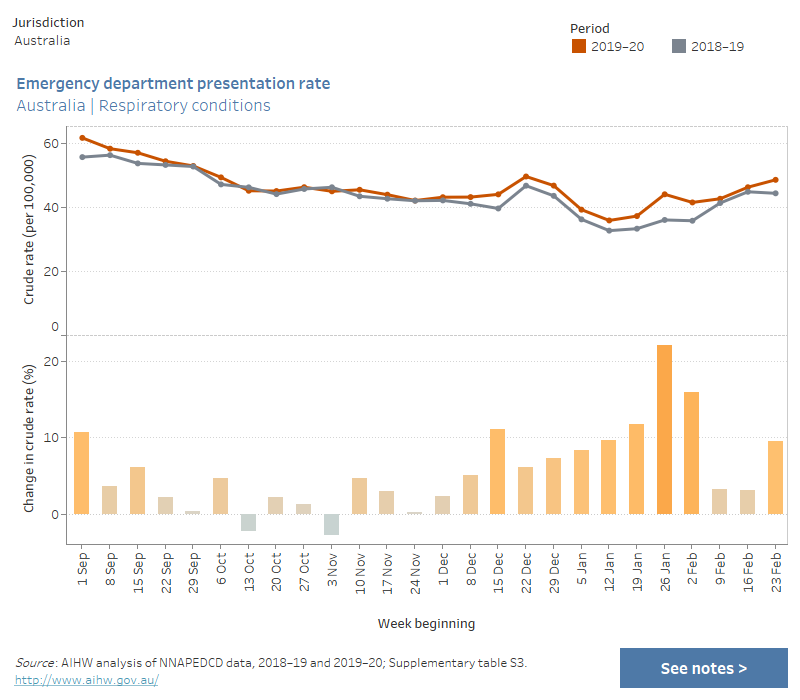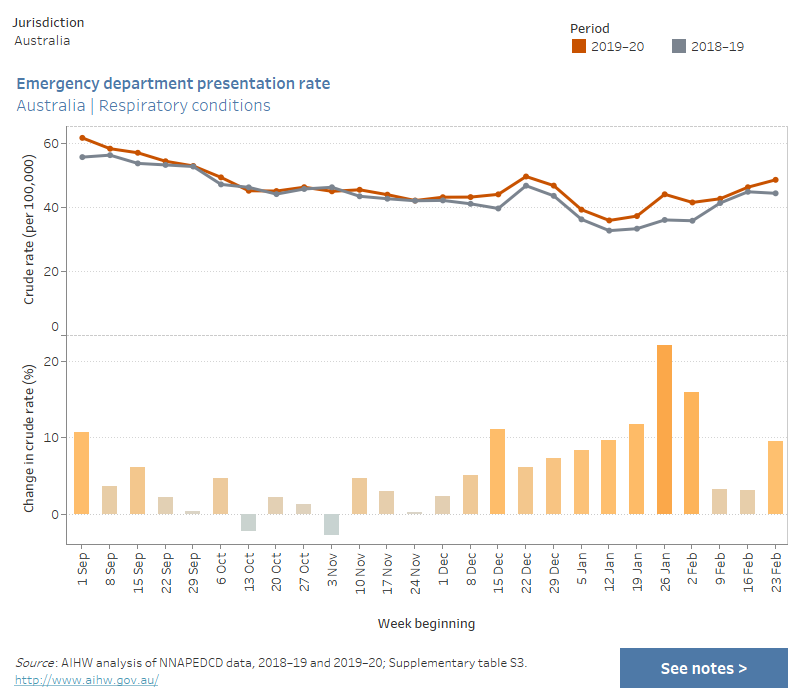Heart, stroke and vascular conditions
While the evidence for an association between air pollution from bushfire smoke and cardiovascular conditions (which include conditions such as heart attack and stroke) is not as comprehensive as for respiratory conditions, several studies have found associations (see Australian bushfires 2019–20: exploring the short-term health impacts). It should also be noted that other factors such as extreme heat (Loughnan et al. 2010), which often co-occurs with bushfire, may also lead to increases in ED presentations.
There was no consistent pattern identified between air quality and heart, stroke and vascular conditions in the analysis of ED presentation data for this data update, however the data suggest that further examination of this relationship, particularly with respect to the cumulative effects of prolonged exposure to bushfire smoke, would be of interest.
Selected heart conditions
Nationally, the presentations for selected heart conditions (ICD-10-AM codes I10–I15, I20–I25, I26–I28 and I30–I52) during the 2019–20 bushfire season were generally lower than in the previous year. However, there was an increase of 7.0% in the presentation rate in the week beginning 19 January 2020–18 per 100,000 persons (about 4,600 presentations), compared with 17 per 100,000 in the previous bushfire season (about 4,300 presentations).
During this week, in all jurisdictions except Queensland, there were increases in the presentation rate for selected heart conditions. The smallest and largest increases were:
- a 5.9% increase for New South Wales residents—18 per 100,000 persons (about 1,400 presentations), compared with 17 per 100,000 in the previous bushfire season (about 1,300 presentations)
- a 45% increase for Australian Capital Territory residents—18 per 100,000 persons (75 presentations), compared with 12 per 100,000 in the previous bushfire season (51 presentations).
The results should be interpreted with caution as lower rates of presentation were also observed during the 2019–20 bushfire season (for example, during November and December in New South Wales). It is important to consider that other factors or natural variation in the data may contribute to changes in presentation rates from year to year. In addition, differences in policies or the way presentations are coded between jurisdictions may affect the data.
To explore national data and data for states and territories, see interactive data visualisations below (for data tables see Supplementary table S3).
Emergency department presentation rate, by jurisdiction, selected heart conditions (ICD-10-AM codes I10–I15, I20–I25, I26–I28 and I30–I52), weeks in 2019–20 bushfire season relative to previous year
This combined chart shows the crude rate of emergency department presentations (per 100,000 persons) for selected heart conditions for the periods 2019–20 and 2018–19, and the percentage change in crude rate between the two periods. Data are presented by jurisdiction and by week, for the period 1 September to 29 February/1 March, which correspond to the bushfire season. The chart shows that nationally, compared with the previous year, the presentation rate was lower during most weeks. However, there was an increase of 7% in the week beginning 19 January 2020. There were also variations at the jurisdictional level.

At the level of Statistical Area Level 4 (SA4), examples of large increases in the presentation rate for selected heart conditions in the week beginning 19 January 2020, while based on relatively small numbers, include:
- about a 110% increase for Adelaide – Central and Hills residents—10 per 100,000 persons (32 presentations), compared with 5.0 per 100,000 (15 presentations) in the previous bushfire season
- a 90% increase for Sydney – Sutherland residents—20 per 100,000 persons (46 presentations), compared with 11 per 100,000 (24 presentations) in the previous bushfire season.
For data by Statistical Area Level 4 (SA4), see Supplementary table S4.
Heart attack (acute myocardial infarction)
Among presentations for heart conditions, presentations for acute myocardial infarction (AMI; ICD-10-AM code I21), commonly known as heart attack, were also analysed separately as research has found specific associations with smoke pollution from bushfire (see Australian bushfires 2019–20: exploring the short-term health impacts). Note that presentations for AMI are also included within selected heart conditions.
Nationally, increases in emergency department presentations for AMI occurred primarily during a number of weeks in January and February 2020. For example, there was a 13% increase in the presentation rate in the week beginning 5 January 2020—2.8 per 100,000 persons (about 700 presentations), compared with 2.5 per 100,000 in the previous bushfire season (about 610 presentations). A similar increase was observed in the week beginning 19 January 2020.
To explore national data and data for states and territories, see interactive data visualisations below (for data tables see Supplementary table S3).
Emergency department presentation rate, by jurisdiction, AMI (ICD-10-AM code I21), weeks in 2019–20 bushfire season relative to previous year
This combined chart shows the crude rate of emergency department presentations (per 100,000 persons) for acute myocardial infarction for the periods 2019–20 and 2018–19, and the percentage change in crude rate between the two periods. Data are presented by jurisdiction and by week, for the period 1 September to 29 February/1 March, which correspond to the bushfire season. The chart shows that nationally, compared with the previous year, increases in the presentation rate occurred primarily during a number of weeks in January and February 2020. There were also variations at the jurisdictional level.
&embed_code_version=3&tabs=no&toolbar=yes&showAppBanner=false)
At the state and territory level, examples of large increases in the presentation rate for AMI coinciding with periods of significant fire activity or air pollution included:
- a 21% increase in the week beginning 2 February 2020 for New South Wales residents—2.8 per 100,000 persons (about 225 presentations), compared with 2.3 per 100,000 in the previous bushfire season (185 presentations). In general, there were increases in emergency department presentations for AMI for most weeks from the beginning of September to the middle of November 2019 and between 22 December 2019 and 15 February 2020. However, there were also decreases in the rate at times when air pollution levels from bushfire smoke were high (mid-November to mid-December), so it was difficult to identify a clear relationship between exposure and presentations
- an 18% increase in the week beginning 5 January 2020 for Victorian residents—2.5 per 100,000 persons (about 160 presentations), compared with 2.1 per 100,000 in the previous bushfire season (about 135 presentations). A 39% increase was observed in the week beginning 2 February 2020, however the relatively lower rate in the year before appears to have influenced the rate increase, so part of the rate increase may be due to natural variation in the data.
Because the numbers of AMI presentations at the level of Statistical Area Level 4 (SA4) were generally small, data are not presented at this level.
For data by Statistical Area Level 4 (SA4), see Supplementary table S4.
Cerebrovascular conditions
There is some evidence to suggest that exposure to bushfire smoke may increase the incidence of cerebrovascular conditions (ICD-10-AM codes I60–I69), including stroke (Edwards et al. 2018), therefore, presentations for cerebrovascular conditions were analysed.
Nationally, there were increases in presentations for cerebrovascular conditions during all of January and February 2020, compared with the previous bushfire season. There was an increase in the presentation rate of 8.1% in the week beginning 19 January 2020—3.4 per 100,000 persons (about 850 presentations), compared with 3.1 per 100,000 in the previous bushfire season (about 780 presentations). A similar increase was observed in the week beginning 29 December 2019. There were also increases earlier in the season coinciding with, or following times when air pollution from bushfires was elevated (Arriagada et al. 2020; supplementary material).
To explore national data and data for states and territories, see interactive data visualisations below (for data tables see Supplementary table S3).
Emergency department presentation rate, by jurisdiction, cerebrovascular conditions (ICD-10-AM codes I60–I69), weeks in 2019–20 bushfire season relative to previous year
This combined chart shows the crude rate of emergency department presentations (per 100,000 persons) for cerebrovascular conditions for the periods 2019–20 and 2018–19, and the percentage change in crude rate between the two periods. Data are presented by jurisdiction and by week, for the period 1 September to 29 February/1 March, which correspond to the bushfire season. The chart shows that nationally, compared with the previous year, the presentation rate increased during all of January and February 2020. There were also variations at the jurisdictional level.

At the state and territory level, examples of large increases in the presentation rate of cerebrovascular conditions coinciding with periods of significant fire activity or air pollution included:
- a 14% increase in the week beginning 27 October 2019 for New South Wales residents—3.8 per 100,000 persons (about 310 presentations), compared with 3.3 per 100,000 in the previous bushfire season (about 265 presentations). A 12% increase was observed in the week beginning 3 November 2019.
- an 18% increase in the week beginning 10 November 2019 for Queensland residents—3.0 per 100,000 persons (about 155 presentations), compared with 2.5 per 100,000 in the previous bushfire season (about 125 presentations). A 23% increase was observed in the week beginning 24 November 2019.
Because the numbers of cerebrovascular condition presentations at the level of Statistical Area Level 4 (SA4) were generally small, data are not presented at this level.
For data by Statistical Area Level 4 (SA4), see Supplementary table S4.
References
Arriagada NB, Palmer AJ, Bowman DM, Morgan GG, Jalaludin BB & Johnston FH 2020. Unprecedented smoke-related health burden associated with the 2019–20 bushfires in eastern Australia. Medical Journal of Australia 213(6): 282–3.
Edwards LJ, Williamson G, Williams SA, Veitch MGK, Salimi F & Johnston FH 2018. Did fine particulate matter from the Summer 2016 landscape fires in Tasmania increase emergency ambulance dispatches? A case crossover analysis. Fire 1(2):1–11.
Loughnan ME, Nicholls N & Tapper NJ 2010. When the heat is on: threshold temperatures for AMI admissions to hospital in Melbourne Australia. Applied Geography 30(1):63–9.


